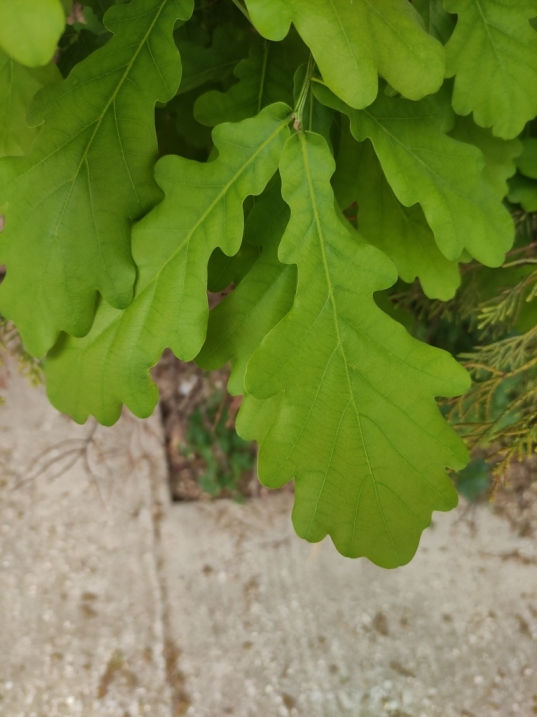Research in Context
Tree species in the genus Quercus
%20Ancient%20Agora%20of%20Athens%20-%20(20240113)%20300%20dpi%20.jpg)
Quercus ithaburensis subsp. macrolepis
Fagaceae

Distribution in Athens In the parks of Ancient Agora, Dasos Syggrou, NTUA campus, monastery of Penteli. Its natural distribution in Greece extends to deciduous forests in the country's Mediterranean zone (Pantera et al, 2009).
Biomes subtropical
Area of origin SE. Italy, Balkan Peninsula to Syria.
Countries in the area of origin Albania, Bulgaria, East Aegean Is., Greece, Italy, Kriti, Lebanon-Syria, NW. Balkan Pen., Türkey, Türkey-in-Europe.
Tree inventories In two inventories in cities in Northern Greece: Arta, Ioannina In addition, it is present in another 6 inventories abroad: France (Bordeaux, Paris), Switzerland (Basel, Geneva), Israel (Karmiel, Tel Aviv).
Performance It seems to be performing well in parks. However the surroundings are more forest like than urban green. It seems to be self-reproducing and expanding in the ecosystems of Dasos Syggrou and the NTUA campus.
Literature references Oaktopia webite lists.

Quercus robur
Fagaceae

Distribution in Athens New plantings in the northern borough of Gerakas.
Biomes temperate
Countries and regions
Area of origin Europe to Iran.
Countries in the area of origin Albania, Altay, Austria, Baltic States, Belarus, Belgium, Bulgaria, Central European Russia, Corse, Czechia-Slovakia, Denmark, East European Russia, Finland, France, Germany, Great Britain, Greece, Hungary, Iran, Ireland, Italy, Kriti, Krym, Netherlands, North Caucasus, North European Russia, Northwest European Russia, Norway, NW. Balkan Pen., Poland, Portugal, Romania, Sardegna, Sicilia, South European Russia, Spain, Sweden, Switzerland, Transcaucasus, Türkey, Türkey-in-Europe, Ukraine
Global Distribution (Introduced) Canada (British Columbia, New Brunswick, Nova Scotia, Prince Edward I.), Spain (Canary Islands), South Africa (Cape Provinces, Free State, KwaZulu-Natal, Lesotho), USA (Colorado, New York, Kentucky), , Portugal (Madeira), New Zealand North, New Zealand South, Réunion, St.Helena.
Cities worldwide
Tree inventories A popular urban tree species with presence in 163 inventories around the world:
OCEANIA: Australia, New Zealand
AMERICAS: Argentina, Brazil, Canada, Chile, USA
EUROPE: Belgium, Croatia, Czech Republic, Denmark, Finland, France, Germany, Hungary, Ireland, Italy, Netherlands, Norway, Poland, Portugal, Russia, Slovakia, Spain, Sweden, Switzerland, UK, Ukraine,
ASIA: Israel, Turkey, Georgia
AFRICA: South Africa, Zimbabwe.
Literature references Sjöman and Anderson (2023), Oaktopia website lists.

Quercus pubescens
Fagaceae

Distribution in Athens At the parks of Dasos Syggrou and NTUA Campus. It grows in forest areas in the mountains of Attica.
Biomes temperate
Countries and regions
Area of origin Europe to North Türkiye.
Countries in the area of origin Albania, Austria, Belgium, Bulgaria, Corse, Czechia-Slovakia, East Aegean Is., France, Germany, Greece, Hungary, Italy, Kriti, Krym, North Caucasus, NW. Balkan Pen., Romania, Sardegna, Sicilia, Spain, Switzerland, Türkey, Türkey-in-Europe, Ukraine
Global Distribution (Introduced) Poland
Cities worldwide
Tree inventories In 26 inventories.
OCEANIA: Australia
EUROPE: Austria (Vienna), Croatia (Zagreb), Denmark, France (Bordeaux, Lyon, Montpellier, Paris), Germany (Frankfurt, Hamburg), Hungary (Budapest), Italy (Bologna, Florence, Turin), Portugal (Lisbon), Spain (Barcelona, Valencia), UK (London), Switzerland (Baselm, Bern, Geneva, Zurich).
Performance It appears to perform well and withstand extreme heat. However the seasonal change of leaves' color to brown may be a disavantage for further use in an urban setting. Maybe with an information campaign, it would be more acceptable to the general public.
Literature references There are references by researchers at the Liege University on the prospect of this species for forest plantings and the climate of the future. (Gembloux Agro-Bio Tech, 2019)
REFERENCES
RESEARCH PROJECTS
ARDEM PROJECT, INRAE
Ducatillion Catherine and Delorme, Sarah. 2022.
ARbres de Demain En Méditerranée (ARDEM) projet brochure. Villa de Thuret, INRAE.
https://jardin-thuret.hub.inrae.fr/content/download/6148/49641?version=1
INRAEJardin Botanique Villa Thuret. 2022
“Arbres de demain - Fiches espèces.” Modified on March 25, 2024.
https://jardin-thuret.hub.inrae.fr/actualites/presentation-des-fiches-especes
PAPERS
Pantera, Anastasia & Papadopoulos, Andreas & Fotiadis, Georgios & Papanastasis, V.. (2009). Distribution and phytogeographical analysis of Quercus ithaburensis ssp. macrolepis in Greece. Ecologia Mediterranea. 34. 73-82. 10.3406/ecmed.2008.1400.
Maribel Carol-Aristizabal, Jérôme Dupras, Christian Messier, Rita Sousa-Silva. 2024. “Which Tree Species Best Withstand Urban Stressors? Ask the Experts”. Arboriculture & Urban Forestry (AUF) Jan 2024, 50 (1) 57-75.
https://doi.org/10.48044/jauf.2023.026
BOOKS
Sjöman, Henrik, and Anderson, Arit 2023. The Essential Tree Selection Guide: For Climate Resilience, Carbon Storage, Species Diversity and Other Ecosystem Benefits. London: Filbert Press
ARTICLES
Ferrini, Francesco. 2023. “The right tree in the right place.” Interview by Maurizio Lapponi. FLORACULTURE INTERNATIONAL. International Association of Horticultural Producers (AIPH). October 1, 2023.
https://aiph.org/floraculture/news/the-right-tree-in-the-right-place/
WEBSITES
Oaktopia. n.d. About Dave - Apple Park. Accessed January 31, 2024.
https://www.oaktopia.org/about
LIÈGE université, Gembloux Agro-Bio Tech, n.d. “Carte blanche : « Quels arbres pour la forêt de demain?» ”. Le Soir. Published, November 5, 2019.
https://www.gembloux.uliege.be/cms/c_5353333/en/carte-blanche-quels-arbres-pour-la-foret-de-demain
